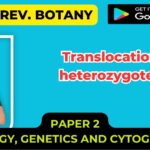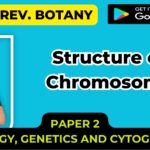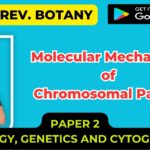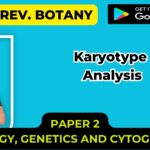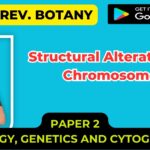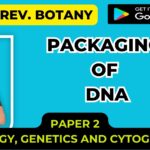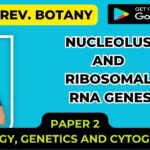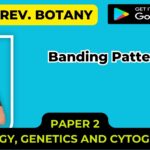![]()
CHROMATIN EUCHROMATIN AND HETEROCHROMATIN
- Chromatin is found in two varieties: euchromatin and heterochromatin.
- In 1928, Heitz defined heterochromatin as, -those regions of the chromosome that remain condensed during interphase and early prophase are called chromocentre.
- The rest of the chromosome which is in a non condensed state was called euchromatin.
- Originally, the two forms were distinguished cytologically by- how intensely they stained – the euchromatin is less intense, while heterochromatin stains intensely, indicating tighter packing.
- Heterochromatin is usually localized to the periphery of the nucleus.
Heterochromatin
- Heterochromatin mainly consists of genetically inactive satellite sequences, and many genes are repressed to various extents, although some cannot be expressed in euchromatin at all. Both centromeres and telomeres are heterochromatic, as is the Barr body of the second inactivated X chromosome in a female Heterochromatic regions are considered into three structures namely chromomeres, chromocentres and knobs.
- Chromomeres are regular feature of all prophase chromosomes, large enough to reveal them, but their number, size; distribution and arrangement are specific for a particular species at a particular stage of development.
- Chromocentres are heterochromatic regions of varying size which occur near the centromeres in proximal regions of chromosome arms.
- At mid-prophase, many chromocentres can be resolved into strings of chromomeres, which are larger than chromomere found in distal regions. In some dipteran salivary glands, the chromocentres of different chromosomes fuse to form a large chromocentre.
- The relative distributions of chromocentres are sometimes considered to be of considerable evolutionary value.
- Knobs are spherical heterochromatin bodies which may have a diameter equal to the chromosome width but may reach a size having a diameter which is several times the width of the chromosome.
- Very distinct chromosome knobs can be observed in maize at pachytene stage.
- Knobs are valuable chromosome markers for distinguishing chromosomes of related species and races.
Function
- Heterochromatin is believed to serve several functions, from gene regulation to the protection of the integrity of chromosomes; all of these roles can be attributed to the dense packing of DNA, which makes it less accessible to protein factors that bind DNA or its associated factors.
- For example, naked double-stranded DNA ends would usually be interpreted by the cell as damaged DNA, triggering cell cycle arrest and DNA repair.
- Some regions of chromatin are very densely packed with fibres displaying a condition comparable to that of the chromosome at mitosis.
- Heterochromatin is generally clonally inherited; when a cell divides the two daughter cells will typically contain heterochromatin within the same regions of DNA, resulting in epigenetic inheritance.
- Variations cause heterochromatin to encroach on adjacent genes or recede from genes at the extremes of domains.
- Transcribable material may be repressed by being positioned (in cis) at these boundary domains.
- This gives rise to different levels of expression from cell to cell, which may be demonstrated by position-effect variegation. Insulator sequen-ces may act as a barrier in rare cases where constitutive heterochromatin and highly active genes are juxtaposed (e.g. the 5’HS4 insulator upstream of the chicken β-globin locus, and loci in two Saccharomyces spp).
Types of Heterochromatin
Constitutive heterochromatin
- All cells of a given species will package the same regions of DNA in constitutive heterochromatin, and thus in all cells any genes contained within the constitutive heterochromatin will be poorly expressed.
- For example, all human chromosomes 1, 9, 16, and the Y chromosome contain large regions of constitutive heterochromatin. In most organisms, constitutive heterochromatin occurs around the chromosome centromere and near telomeres.
Facultative heterochromatin
- The regions of DNA packaged in facultative heterochromatin will not be consistent between the cell types within a species, and thus a sequence in one cell that is packaged in facultative heterochromatin (and the genes within poorly expressed) may be packaged in euchromatin in another cell (and the genes within no longer silenced). However, the formation of facultative heterochromatin is regulated, and is often associated with morphogenesis or differentiation.
- An example of facultative heterochromatin is X-chromosome inactivation in female mammals: one X chromosome is packaged as facultative heterochromatin and silenced, while the other X chromosome is packaged as euchromatin and expressed.
- Among the molecular components that appear to regulate the spreading of heterochromatin include the Polycomb-group proteins and non-coding genes such as Xist. The mechanism for such spreading is still a matter of contrive.

Euchromatin
- Euchromatin is a lightly packed form of chromatin that is rich in gene concentration, and is often (but not always) under active transcription.
- Unlike heterochromatin, it is found in both eukaryotes and prokaryotes.
- Euchromatin comprises the most active portion of the genome within the cell nucleus.
Structure
- The structure of euchromatin is reminiscient of an unfolded set of beads along a string, where those beads represent nucleosomes.
- Nucleosomes consist of eight proteins known as histones, with approximately 147 base pairs of DNA wound around them; in euchromatin this wrapping is loose so that the raw DNA may be accessed.
- Each core histone possesses a `tail’ structure which can vary in several ways; it is thought that these variations act as “master control switches” which determine the overall arrangement of the chromatin.
- In particular, it is believed that the presence of methylated lysine 4 on the histone tails acts as a general marker for euchromatin.
Appearance
- Euchromatin generally appears as light-colored bands when stained in GTG banding and observed under an optical microscope; in contrast to heterochromatin, which stains darkly.
- This lighter staining is due to the less compact structure of euchromatin.
- The basic structure of euchromatin is an elongated, open, 10nm microfibril, as noted by electron microscopy.
- It should be noted that in prokaryotes, euchromatin is the only form of chromatin present; this indicates that the heterochromatin structure evolved later along with the nucleus, possibly as a mechanism to handle increasing genome size.
Function
- Euchromatin participates in the active transcription of DNA to mRNA products.
- The unfolded structure allows gene regulatory proteins and RNA polymerase complexes to bind to the DNA sequence, which can then initiate the transcription process.
- Not all euchromatin is necessarily transcribed, but in general that which is not is transformed into heterochromatin to protect the genes while they are not in use.
- There is therefore a direct link to how actively productive a cell is and the amount of euchromatin that can be found in its nucleus.
- It is thought that the cell uses transformation from euchromatin into heterochromatin as a method of controlling gene expression and replication, since such processes behave differently on densely compacted chromatin- this is known as the `accessibility hypothesis’.
- One example of constitutive euchromatin that is ‘always turned on’ is housekeeping genes, which codes for the proteins needed for basic functions of cell survival

